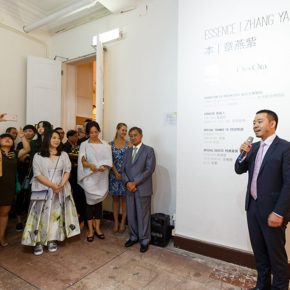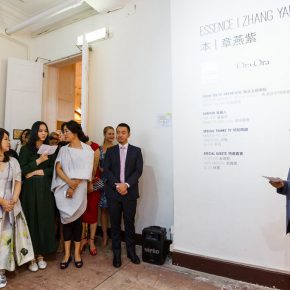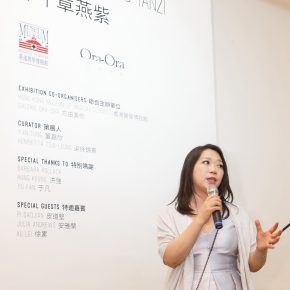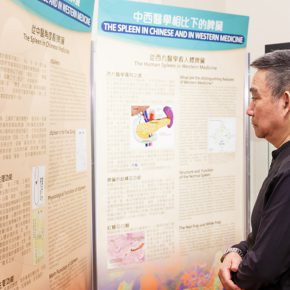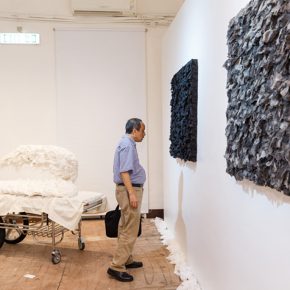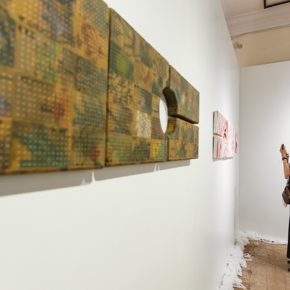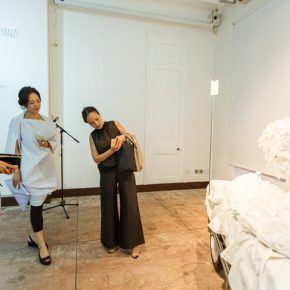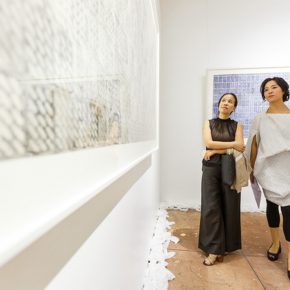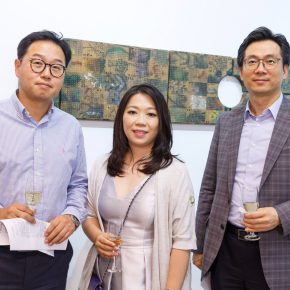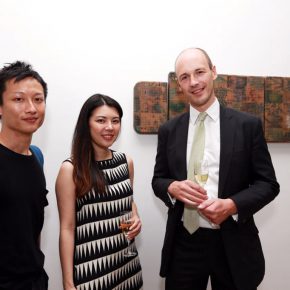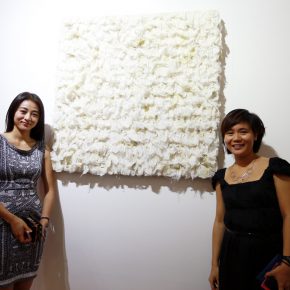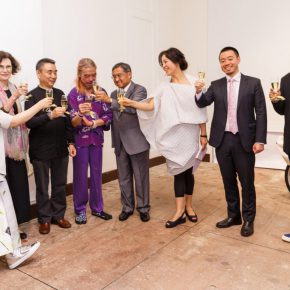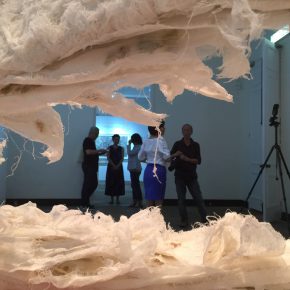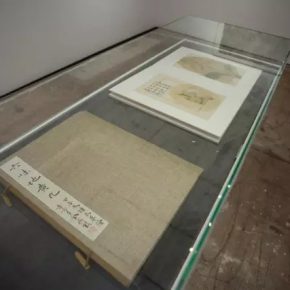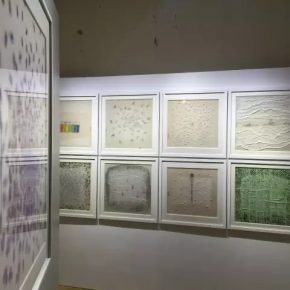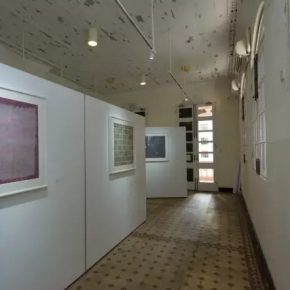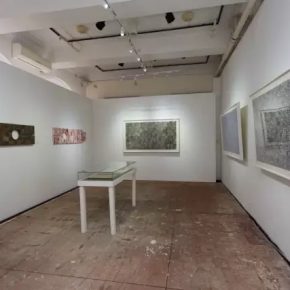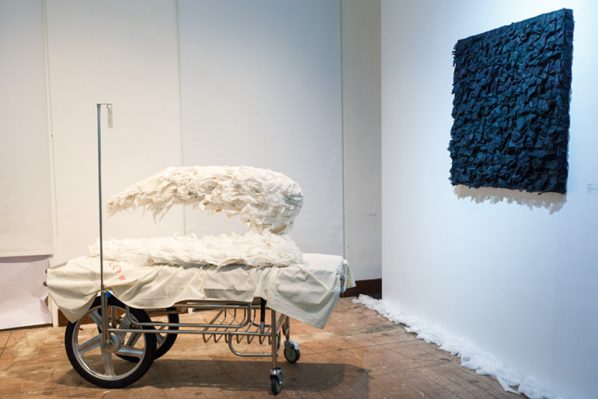
At 18:00 on July 8th 2016, the artist Zhang Yanzi introduced her solo show entitled Essence featuring her recent works, which has been in construction for nearly a year, to Hong Kong Museum of Medical Sciences. The exhibition is coorganized with Hong Kong Museum of Medical Sciences and Ora-Ora Gallery, and it showcases the artist’s new series of creations after her series entitled “Remedy”. Mr. Ronald Chan Ngokpang, JP, Under Secretary for Constitutional and Mainland Affairs, HKSAR Government, the artist Xu Lei, art critic Pi Daojian, Dr Y.L. Yu, Chairman of HKMMS Society, Julia Andrews, American professor of art history at Ohio State University, Hong Kong M + Museum senior curator Pi Li, Ms. Henrietta Tsui-Leung, Founder of Galerie Ora-Ora, Yan Tung, Curator of the Hong Kong Museum of Medical Sciences and so on attended the opening ceremony. The exhibition is also the tenth anniversary party of the Ora-Ora Gallery and the the twentieth anniversary celebration of Hong Kong Museum of Medical Sciences.
Zhang Yanzi has been concerned with the "medical" theme since 2010, it seems that she has found a perfect fit for her artistic expression, but she also received great concern by the academia. In the artist's own words, her creative process before she reached her destination was always tangled, as well as painful, when exploring the theme of "Remedy", it seemed that she had found an analgesic for her own pain. Currently creation for her is a very smooth experience. Many of her friends seem to equate the identity of Zhang Yanzi with the doctor, usually she was asked as to how to cure their minor illness. She admitted that she was only an artist, she took it as a theme just trying to find a common point between the body of the contemporary with mental comfort. As for the transition "Essence”, Zhang claimed they were the result of "her growth", she did not know the next step leading up to her art, she did not deliberately plan it, everything is natural growth.
For Zhang Yanzi’s art, critic Pi Daojian mentioned in an interview conducted by CAFA ART INFO that, she was an outstanding representative of contemporary ink art, which is not only the continuation of the traditional Chinese context, but also reflected her deep perception and thinking on traditional culture as well as calligraphy. Besides she was very keen to the sensitivity of material and its physical nature. For example, the works exhibited in the Hong Kong Museum of Medical Sciences made use of new materials that have never been used in ink and wash paintings. The use of them conveys more humane care in a medical museum environment. Although the boundaries of contemporary art should be made a breakthrough, I think the ink and wash elements here for Zhang Yanzi are a kind of cultural spirit.
Compared to her previous creation, the works for this exhibition present more social and human values, as her previous works placed more emphasis on the the creation of self-perception and expression of the artist, this exhibition starts mostly from life, social, public experiences and memories. A year ago, Zhang Yanzi was invited to Hong Kong Museum of Medical Sciences and she took up an art residence there. The museum is a medical-themed museum in Hong Kong, it describes the history of Medicine in Hong Kong, and it explains the differences between traditional Chinese medicine and Western medicine for the treatment of patients. During her stay of two weeks, Zhang Yanzi understood the history of the museum, and she observed the plantations of medical herbs, to complete the creation of the fight in more than a year: "Resuscitation", "Sanctuary", "Empty Chip " and “Inescapable”.
During the period of Japanese occupation, the predecessor of the Museum became the bacteriological examination of the detention camps, Professor Robert Cecil Robertson tried to avoid stress from the Japanese and he decided to commit suicide in 1942. This historical story deeply touched Zhang Yanzi, thus she formed a huge contrast between the powerful spirit and fragile flesh, to form her work named “Resuscitation", the works appear as "Angel Wings" visually, the feathers in the artist's familiar authoring language demonstrate extending treatment, as the artist tore the medical gauze into small pieces, and Chinese herbal medicine was wrapped by them, pieces of “medical feathers” exude the taste of medicine gradually grown over the wings, it told a story of "hope and salvation”, but it also inspired people to deeply ponder on the value of life. "Sanctuary" is deliberately created by her on the basis of her visit to the museum, it originated from an operating table collected by the museum. Taking advantage of this bed as it continued to nurture lives, she expressed her pain and respect as a woman and a mother who gives birth to life. The surface of the work was painted with herbs "remedy" as coverage, but they were painted from herbs for research use by the museum. The exhibition next to this art exhibition is a permanent exhibition of the Hong Kong Museum of Medical Sciences, in the form of popular science about human conception, embryonic growth, fertility production process from different perspectives of science and art telling about the same topic, also for the audience to feel a more vivid experience. Artist Xu Lei thought that this exhibition fits the environment of the Hong Kong Museum of Medical Sciences while it extended the previous topics, it is also endowed with the nature of "Project" as it enhanced the "ritual sense" of medical science through art, conveying the metaphysical spirit in a fusion of nature together with traditional Chinese medicine.
Art and science, seem to belong to two different spatial experiences of human knowledge, one is in a rational pursuit of precision, and the other is in a wanton pursuit of the sensual, but in the development of human knowledge they are inseparable from each other, the Renaissance masters with a scientific attitude towards the arts try to enhance the art and science equally important position in modern scientific progress, this has also spawned a variety of modern art forms. The integration of Zhang Yanzi’s ink art and medical science was a metaphysical combination, as Ms. Yan Tung, Curator of the Hong Kong Museum of Medical Sciences said, "Essence" is a poem about scientific research, imagination and observation.
The Curatorial Statement for Essence
Medical science cures the body, yet art heals the mind. Medical science gives us hope for curing our bodies, as we benefit from the tireless dedication, meticulous research and accumulation of knowledge from generations of medical practitioners. Art, on the other hand, often serves as a philosophical and emotional conduit that exposes society’s happiness, concerns and spirit. [本] or “Essence” is the rare cross-over exhibition that interweaves the sensuality of modern medicine and sensibility of personal expressions through life’s journey, from birth to death.
The Hong Kong Museum of Medical Sciences, throughout its century-old history and many roles, has faithfully served Hong Kong since the early days of colonialization. Whether as the frontier of bacteriology and immunization research, or as an incubator of the first corps of locally-trained western medical nurses, this institution embodies the devotion of and battles won by countless medical experts in Hong Kong, and the exchange between modern and traditional medicine. Having spent a summer at the Museum as an artist-in-residence, Zhang Yanzi was deeply touched by the strife, rigor, breakthrough and passion in painting the medical history of Hong Kong. As a result, Zhang created a completely new series of work that not only blends art and medicine on both visual and philosophical levels, but also infuses her unique interpretation of and feelings for humanity’s essence of suffering and remedy, and medical workers’ noble spirit and selflessness.
With gauze bandages, analgesic plasters, Chinese medicine, aluminum blister packs, Zhang deftly walks between medicine and art, exploring the most graphic of pains juxtaposing against the freest of ideologies. Her expression of simultaneous reliance and resistance to modern medicine shows her contradicting concerns. The viewer is subjected to these psychological contortions, but is eventually caressed to recovery through Zhang’s graceful oriental aesthetics. As medicine cures the body, yet art can heal the spirit, is art then the medicine?
Through this exhibition, our curatorial purpose is not only to strike a dialogue between medicine and art, as other illustrative artists have done, but also to excite visitors with thoughts, emotions and senses never before experienced, and explore together the intricate vastness behind sacrifice and remedy.
About the exhibition
Duration: 8 July to 28 August
Tuesday to Saturday: 10 am to 5 pm
Sunday & Public Holidays: 1 pm to 5 pm
Venue: Hong Kong Museum of Medical Sciences
Address: 2 Caine Lane, Mid-Levels, Sheung Wan, Hong Kong
Text by Zhang Wenzhi, translated and edited by Sue/CAFA ART INFO
Courtesy of the artist and Hong Kong Museum of Medical Sciences, Photo Credit of Ora-Ora Gallery, for further information please visit www.hkmms.org.hk/zh/home-zh/ or contact Sinclair Communications at (852) 2915 1234


